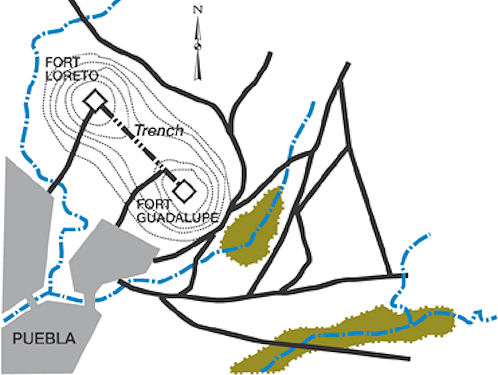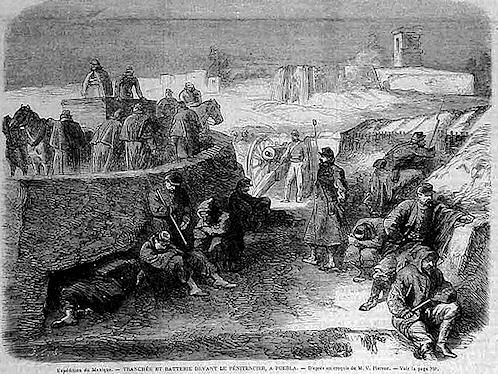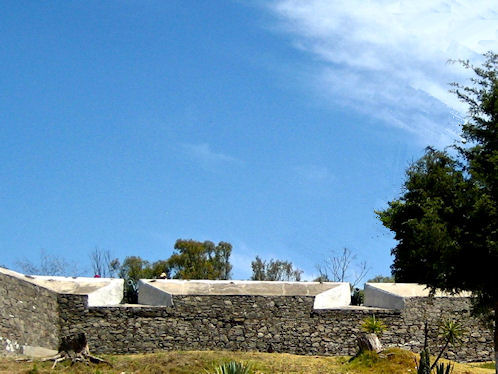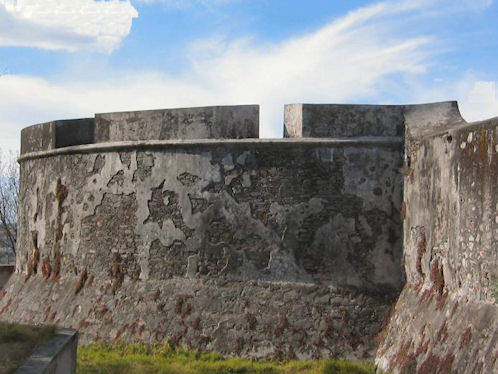The Battle of Puebla.
Puebla, México.
Travel & Tour
Pictures, Photos, Images, & Reviews.
George & Eve DeLange
Google Map To The Forts of Loreto and Guadalupe.
Puebla, México.
View Larger Map
We Are Proud Of Our SafeSurf Rating!
Click On Any Of The Following Links By Amazon.Com
For Cinco de Mayo Party Items. No Obligation!

Cinco de Mayo, The Battle of Puebla. Puebla, México. May 5, 1862. Image Courtesy Of: Wikipedia, the free encyclopedia. 
The Siege of Puebla. Puebla, México. From March 29 to May 17, 1863. Image Courtesy Of: Wikipedia, the free encyclopedia.
 |
| Cinco de Mayo, The Battle of Puebla. Puebla, México. May 5, 1862. Image Courtesy Of: Wikipedia, the free encyclopedia. |
|---|
 |
| The Siege of Puebla. Puebla, México. From March 29 to May 17, 1863. Image Courtesy Of: Wikipedia, the free encyclopedia. |
We wish to thank Wikipedia, the free encyclopedia for some of the information on this page. We share information, & images with Wikipedia. We also donate to their funding. If you ask most of the people in the United States what Cinco de Mayo is about; most will say it's Mexico's Independence Day. Well, that is wrong! On this page we will try to explain what Cinco de Mayo is really about. The simple answer is that Cinco de Mayo celebrates the Battle of Puebla, México; which took place on May 5, 1862. We have to admit that we had been in the city of Puebla, several times, before we learned the correct answer. Oh, Mexico's Independence Day is commemorated on September 16, the anniversary of the revolutionary priest Miguel Hidalgo y Costilla’s famous “Grito de Dolores” (“Cry of Dolores”), a call to arms that amounted to a declaration of war against the Spanish colonial government in 1810.
|
Mexico's economy was very depressed after the 1858–60 Mexican civil war known as the Reform War. In 1861 Benito Juárez, who represented the Liberal political party, and who was elected President Of Mexico, suspended payments of interest upon foreign debts, for a period of two years. This angered the governments of Spain, France, and Britain. At the end of October of 1861 diplomats from Spain, France, and Britain met in London to form what was known as the Tripartite Alliance, the main purpose of which was to launch an invasion into Mexico, and then to take control of Veracruz, its major port, and force the Mexican government to negotiate terms for the repayment of its debts and for the reparations for it's alleged harm to foreign citizens living in Mexico. In December of 1861, Spanish forces landed in Veracruz; and then the British and French forces arrived in early January of 1862. The soldiers of these three armies then captured and occupied the city of Veracruz and then advanced onward to Orizaba. Then, in early April of 1862, the Tripartite Alliance fell apart because the French government wanted to impose harsh demands upon the Mexican - Juarez government, and to provoke war against Mexico. At that point, the British and Spanish troops withdrew from Mexico, leaving the French troops alone to march upon Mexico City. During this event, Napoleon III of France was using the opportunity (lack of attention to Mexico by the United States) being created by the American Civil War, fought from 1861 to 1865, to set up the presence of a puppet Mexican regime, controlled by France, in the America's.
|
Events Before The Battle:
The French forces’ under the command of General Charles de Lorencez had agreed to withdraw to the coast of Mexico. When the Mexican people saw these French soldiers on the march, they took it that hostilities had begun again and they felt threatened. Then it was discovered that the political negotiations for the withdrawal of the French troops had broken down. Then a very strong complaint was lodged by the Mexicans to General Lorencez, who took their insolence as a plan to assail his forces. General Lorencez then decided to postphone his withdrawal to the coast and he had his troops to occupy the city of Orizaba, along what has been for centuries the main trade route between Mexico City and Veracruz on the Gulf Coast. This lone French force, led by General Charles de Lorencez, chased the locals out of Orizaba, which included a handful of Mexican soldiers and their commander, General Ignacio Zaragoza Seguin. This occupation of Orizaba by the French prevented the Mexican Army from being able to defend the passes located between the city of Orizaba and the landing port of Veracruz. The Mexican soldiers and their commander, General Ignacio Zaragoza Seguin were forced to fall back to a place called Acultzingo Pass, There on April 28, 1862 they were beaten by the French and they fell back yet again to Puebla.
The Battle of Puebla:
Puebla was heavily fortified – it had been held by the Mexican government since the Reform War. To its north stood the forts of Loreto and Guadalupe on opposite hilltops. General Zaragoza had a trench dug to join the forts via the saddle. General Charles de Lorencez of France was led to believe that the people of Puebla were friendly to the French, and that the Mexican Republican garrison which kept the people in line would be overrun by the Mexican population once he made a show of force. This move on his part was one big mistake! For several reasons. So on May 5, 1862; when General Charles de Lorencez decided to attack Puebla from the north, he began his attack too late in the day. He used his artillery just before noon. Then, he advanced his infantry by noon. Then, he started his third attack which required the full engagement of all his army's reserves. But, the French artillery had run out of ammunition, so the third infantry attack went unsupported. The Mexican forces and the Republican garrison had both put up such a strong defense that they even took to the field to defend their positions in the saddle between the hilltop forts of Loreto & Guadalupe. Then, when the French retreated from their final assault, Zaragoza had his cavalry attack them from the right and left, while Mexican troops concealed along the road pivoted out they flanked them badly. Then, by about 3 p.m. the daily rains had started, making a slippery quagmire of the battlefield. This forced General Lorencez of France to withdraw to very distant positions away from Puebla. His army counted 462 of his men killed against only 83 of the Mexicans. General Lorencez waited a few days for General Zaragoza to attack again, but Zaragoza held his ground. This forced General Lorencez to completely withdrew back to Orizaba. Credit for the Mexican victory is shared by a young officer (and future president), Brigadier General Porfirio Díaz, who succeeded in turning back a flank of the invading French army. Slowed by their loss at Puebla, the French forces retreated and regrouped, and the invasion continued after Napoleon III determinedly sent additional troops to Mexico. The French were eventually victorious, winning the Second Battle of Puebla on 17 May 1863 and pushing on to Mexico City. When the capital fell, Benito Juárez's government was forced into exile in the remote north of Mexico. Seeking to legitimize French rule in Mexico, Napoleon III invited Maximilian to establish a new Mexican monarchy called, the Second Mexican Empire. With the support of the French army and a group of conservative Mexican monarchists, Maximilian traveled to Mexico where he declared himself Emperor of Mexico on 10 April 1864. Ferdinand Maximilian; (6 July 1832 – 19 June 1867) was the only monarch of the Second Mexican Empire. He was a younger brother of the Austrian emperor Franz Joseph I. He had conspired with Napoleon III to make a monarchy of Mexico.
|
The Battle of Puebla's Significance:
The Battle of Puebla was an inspirational event for wartime Mexico, and it provided a stunning revelation to the rest of the world which had largely expected a rapid victory for French arms. While the Battle of Puebla was not a major strategic victory in the overall war against the French, General Zaragoza's victory at Puebla tightened Mexican resistance, and six years later France withdrew its forces from Mexico. During that same year, Austrian Archduke Ferdinand Maximilian, who had been installed as emperor of Mexico by Napoleon III in 1864, was captured and executed by Benito Juarez' forces. Maximilian was executed by a firing squad. He spoke only in Spanish and gave his executioners a portion of gold not to shoot him in the head so that his mother could see his face. His last words were, "I forgive everyone, and I ask everyone to forgive me. May my blood which is about to be shed, be for the good of the country. Viva Mexico, viva la independencia!"
On 9 May 1862, President Benito Juárez declared that the anniversary of the Battle of Puebla would be a national holiday, called the "Battle of Puebla Day" or "Battle of Cinco de Mayo." It is not a federal holiday in Mexico. Since the 1930s, a re-enactment of the Battle of Puebla has been held each year at Peñón de los Baños, a rocky outcrop close to Mexico City International Airport.
|
The Mexico City International Airport (Spanish: Aeropuerto Internacional de la Ciudad de México or AICM), also called Benito Juárez International Airport (IATA: MEX, ICAO: MMMX) is the major commercial airport that serves Mexico City, the capital of Mexico. It is also Mexico's and Latin America's busiest airport! The Hermanos Serdán International Airport (IATA: PBC, ICAO: MMPB) is the international airport located near Puebla, Puebla, Mexico. It handles national air traffic for the city of Puebla. It also serves as an alternate airport for Mexico City, being part of the metropolitan airport group for the Mexican capital, comprising the airports of Mexico City, Toluca, Cuernavaca and Querétaro.
To visit this area we would suggest flying into either Mexico City or Puebla and then staying at a hotel of your choice. There are many very good hotels and motels in the area, and if you need a place to stay; Priceline.com can arrange that for you. In fact, we think they are the best way to do it! We have personally, booked flights, hotels, and vacations, through Priceline.com and we can highly recommend them. Their website is very easy to use! We have some links to Priceline.com on this page, since they can arrange all of your air flights, hotels and car. We of course, appreciate your use of the advertising on our pages, since it helps us to keep our pages active. We also have links on this page, that will connect you with several of the best hotels in Mexico City. Hotels that we have personally used! We could, also suggest getting a hotel, and then letting them arrange for either a car, or a tour of Mexico City. If you call their Concierge Services, ahead of your arrival, all of this can be pre-arranged for you. We have used this method, many times, when traveling in Mexico. We have found it to be safe and it works!!! We have never experienced a problem, doing it this way!
|
 |  |
| Cinco de Mayo, The Battle of Puebla. Battlefield Map. Puebla, México. Image Courtesy Of: Wikipedia. | Cinco de Mayo, The Battle of Puebla. Puebla, México. Image Courtesy Of: Wikipedia. |
|---|---|
 | |
| Cinco de Mayo, The Battle of Puebla. Fort Guadalupe. Puebla, México. Image Courtesy Of: Wikipedia. | Cinco de Mayo, The Battle of Puebla. Fort Guadalupe. Puebla, México. Image Courtesy Of: Wikipedia. |
 | |
| Cinco de Mayo, The Battle of Puebla. Fort Loreto. Puebla, México. Image Courtesy Of: Wikipedia. | Cinco de Mayo, The Battle of Puebla. Fort Loreto. Puebla, México. Image Courtesy Of: Wikipedia. |
 |  |
| Cinco de Mayo, The Battle of Puebla. Fort Loreto. Puebla, México. Image Courtesy Of: Wikipedia. | Cinco de Mayo, The Battle of Puebla. Fort Loreto. Puebla, México. Image Courtesy Of: Wikipedia. |
Click On Any Of The Following Links By Amazon.Com
For Books Or Videos About The History Of Cinco de Mayo. No Obligation!
Click On Any Of The Following Links By Amazon.Com
For Books Or Videos About Touring In Mexico. No Obligation!
Click On Any Of The Following Links By Amazon.Com
For Books Or Videos About Touring In Mexico. No Obligation!
Here Are Some Links To The Very Best & Most Popular Items Sold On Amazon.Com
To Learn More! Click The Links Below. No Obligation, Of Course!





